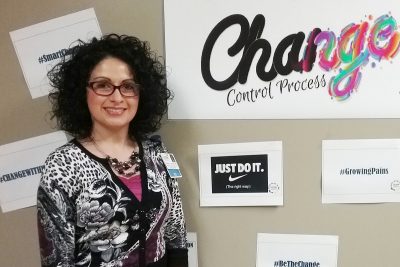
When UConn Health unveils HealthONE in two months, it will be a modern electronic health record system standing not alone, but at the center of a hub of new technology, new roles, new services, and new workflows designed to work together to make the health care experience better for both provider and patient.
Giselle Funchion, assistant director of clinical informatics, breaks it down:
- OneSign (Imprivata) badge-tap sign-in: “It’s our secure and fast way for our providers to use their badge to access patient records, sort of like a fast lane or fast pass,” Funchion says.
- Dragon dictation, already in place in outpatient areas, expanding to include inpatient areas: “We are upgrading our dictation system to integrate with the cloud, which will allow for faster transcription throughout the house.”
- Intellispace obstetrics monitoring for labor and delivery patients: “That will then feed into HealthONE as well for both the monitoring and documentation of those patients.”
- GI Provation procedural documentation system: “We already have gone live with this. All of this procedural information will feed downward into HealthONE.”
- Scribes to facilitate provider documentation and entry into the system: “Over the last 6 months we have introduced scribes on the outpatient side. This new role has helped our physicians move patients along more efficiently with timelier completion of their charts. While the scribes do not enter orders or prescriptions, they enter the documentation based on what the provider’s assessing. This allows the providers to be truly present and in the moment with the patient, hearing and understanding their concerns, while the scribe is taking care of that documentation piece.”
- Epilepsy Monitoring Unit: “We also already have gone live with the EMU, located on the first floor of the University Tower within the intensive care unit. This was a collaboration with our outpatient neurology practice bringing patients in house for controlled seizure monitoring for those patients where traditional regimens might have been unsuccessful.”
- Intake and Change Control to establish a methodical and stringent process for implementing improvements both before and after go-live. “With such a large system as HealthONE and all of these ancillary systems, the change control process will start from the ONErequest (as we’re saying HealthONE), and there’ll be one click for the end user so they can report an issue or request a change. There will be a tightly controlled method to which we prioritize and make those changes to ensure the intended change is made and items aren’t broken along the way.”
And just as the electronic medical record is just one—albeit major—component of HealthONE, the April 28 go-live date is just one—albeit major—milestone in HealthONE’s implementation.
“I don’t see it as the finish line,” Funchion says. Once you reach go-live, you’re now in an optimization phase. It’s the start of a new beginning… many new beginnings. It’s going to need lots of nourishment, lots of maintenance for its lifetime.”
Watch for additional HealthONE updates in Lifeline, in the Pulse, at uconnhealthexpress.uchc.edu/emr, and now on Twitter @UConnHealthONE.